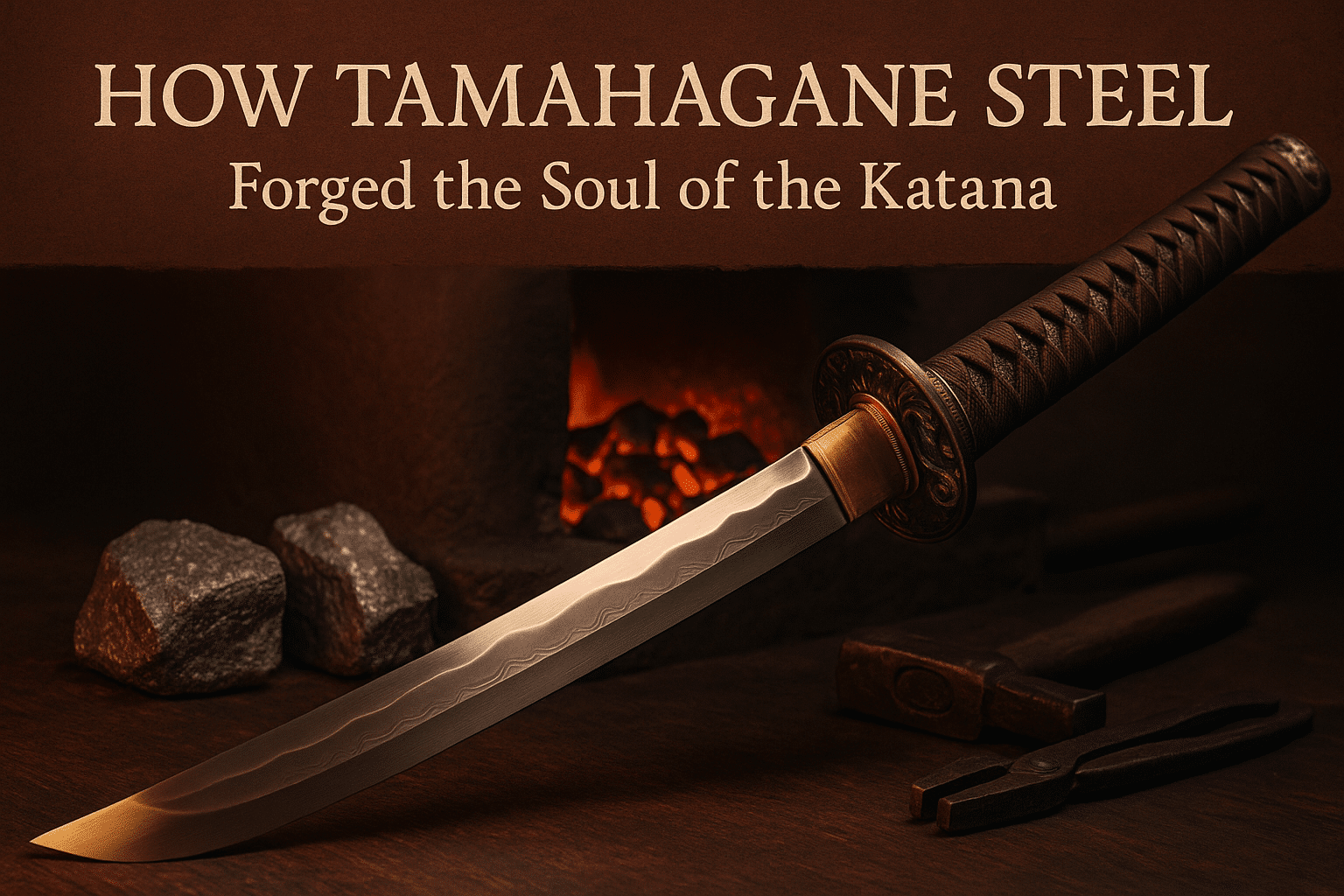The Spirit of the Blade
More than a formidable weapon, the katana stands as a timeless symbol of Japan’s soul—a harmonious blend of lethal functionality and refined artistic expression. Forged from the revered tamahagane steel, each katana carries with it centuries of craftsmanship, philosophy, and cultural identity etched into its blade.
To the samurai, the katana was an extension of the self: not merely a tool of war but a reflection of discipline, honor, and spiritual balance. Every curve and fold of its form tells a story of painstaking precision, where metallurgical mastery meets aesthetic beauty. This is not steel for steel’s sake—it is a living artifact shaped by tradition, ritual, and the relentless pursuit of perfection.
From its elegantly arched silhouette to the distinct hamon (temper line) dancing along its edge, the katana is both sculpture and symbol. It embodies the delicate balance between power and restraint, capturing the very spirit of bushido—the way of the warrior. Through tamahagane’s transformation under fire and hammer, the katana becomes more than a blade; it becomes legacy.
What Is Tamahagane?
Tamahagane, often translated as “jewel steel,” is the traditional Japanese steel used to craft samurai swords, most notably the katana. Its name reflects both the material’s prized nature and the painstaking method by which it is created. Rooted in centuries-old tradition, tamahagane is made using a unique smelting technique that sets it apart from modern steels.
The process begins with satetsu, or iron sand, found primarily in specific regions of Japan such as Shimane Prefecture. This sand comes in two varieties—masa satetsu and akome satetsu—which are carefully blended to achieve an optimal balance of carbon content. The raw materials are then introduced into a tatara furnace, a clay structure operated by skilled artisans known as murage.
Over the course of three continuous days and nights, the tatara is meticulously stoked with charcoal to reach the high temperatures needed for smelting. This allows the iron sand to absorb carbon, transforming into a bloom of steel. Once cooled, the resulting block is broken open to extract layers of tamahagane, which vary in quality depending on their carbon content. Only the finest layers are selected for forging a katana.
This demanding, labor-intensive process yields a steel that is both high in purity and rich in cultural heritage. It’s this foundation—tamahagane—that gives the katana its strength, resilience, and revered status in Japanese craftsmanship.
Forging with Purpose
In the heart of traditional swordsmithing, forging with tamahagane is more than a technical process—it is a ritual of transformation. Beginning with raw blooms of tamahagane steel, the smith cuts, stacks, and heats the fragments, folding and hammering them repeatedly. This laborious process, often repeated dozens of times, expels impurities and creates a fine-grained structure that enhances the steel’s strength and flexibility. With each fold, layers multiply, bonding with intense heat and careful strikes, ultimately producing a blade capable of both elegant sharpness and formidable durability.
But it’s not just the steel that’s refined. The swordsmith, too, is shaped by the rhythm of hammer and fire. Patience, precision, and discipline are honed alongside the blade. Each strike is guided by experience and intuition, ensuring balance, flow, and structural harmony. In this sacred dance of metallurgy and mindfulness, the katana begins to emerge—not simply as a weapon, but as a testament to the focused spirit of its maker.
From Steel to Soul: The Katana’s Transformation
The metamorphosis of tamahagane into a katana is more than an exercise in metallurgy—it’s a sacred ritual, honed through centuries of tradition. It begins with fire and force. The steel, once selected and sorted by quality, is repeatedly heated, folded, and hammered to reduce impurities and align its carbon content. This relentless forging not only strengthens the blade but imbues it with a sense of balance and resilience—qualities both physical and philosophical.
Shaping follows—the blade is purposefully curved and defined through skilled hammering, gradually coaxing out the signature silhouette of the katana. The smith shapes the tang (nakago), spine (mune), and edge (ha), mindful of every angle and proportion, for these dimensions dictate the soul of the sword.
Then comes differential hardening, a process that bridges science and spirit. A special clay mixture is applied—thicker on the spine for softness, thinner along the edge for hardness. Once quenched in water or oil, the result is a hard, razor-sharp edge with a tough, flexible back. It’s this process that creates the hamon, the undulating temper line seen along the blade—a visual testament to the katana’s dual nature.
Finally, the polishing—or togishi—phase reveals the blade’s personality with extraordinary care. This process, which can take weeks, refines the edge, enhances the hamon, and brings out the steel’s texture and coloration. Beyond mere aesthetics, polishing is an act of reverence for what the blade has become: not just a weapon, but a vessel of artistry, discipline, and spirit.
From the raw chaos of tamahagane to the elegance of the finished katana, every strike, fold, and polish breathes life into steel. The transformation is not just one of material—but of soul.
Why Tamahagane Matters
Tamahagane’s legendary status in katana crafting stems from its exceptional balance of hardness and flexibility—qualities essential for a sword that must be both razor-sharp and battle-durable. Derived from smelting iron sand (satetsu) in a traditional tatara furnace, tamahagane undergoes a meticulous, time-intensive refinement process that produces steel with varied carbon content. This variation is precisely what allows swordsmiths to strategically select and fold the steel to optimize performance characteristics.
High-carbon tamahagane forms the blade’s edge, capable of achieving and retaining a keen sharpness, while lower-carbon sections create the spine, lending the sword flexibility and shock resistance. This method not only prevents the blade from easily chipping or snapping under pressure but also enables it to slice with deadly effectiveness. The distinct crystalline structure of tamahagane, developed through repeated folding and differential hardening, results in a katana that’s both a technical marvel and an enduring work of art.
Without tamahagane’s unique metallurgic traits, the katana would not possess the same harmony between precision and power—a harmony deeply embedded in the soul of this storied weapon.
Legacy in Every Blade
For centuries, the soul of the katana has lived within its steel—tamahagane. This rare and revered metal, painstakingly smelted in traditional tatara furnaces, is more than a material; it is a vessel of ancestral wisdom and cultural reverence. When modern swordsmiths shape a blade from tamahagane, they do more than forge a weapon—they honor the legacy of countless generations of artisans who dedicated their lives to perfection in form and function.
Each fold, hammer strike, and quenching bath echoes techniques passed down since the Heian period. The continuity of these practices ensures that every modern katana carries within it not just steel, but the very essence of Japanese tradition. The katana becomes a living artifact—its subtle curves and sharp edge telling stories of samurai code, spiritual craftsmanship, and an enduring pursuit of harmony between beauty and strength.
In preserving the use of tamahagane, swordsmiths affirm more than an aesthetic or technical choice—they affirm identity. They connect past to present, flame to forge, spirit to blade. Through tamahagane, the katana continues to serve not only as a masterwork of metallurgy but also as a timeless icon of cultural pride and artisanal discipline.
Conclusion: Stillness in Steel
In the quiet strength of tamahagane, we find more than just the raw material of a sword—we uncover a philosophy forged in fire and refined through centuries. Its creation, marked by patience, precision, and reverence for nature, mirrors the values embedded in every katana blade. The stillness of steel lies not only in its polished surface but in the timeless dedication of the smith, who transforms base elements into enduring symbols of honor and mastery.
Today, tamahagane continues to captivate for its elegant balance between fragility and resilience. In an age of automation and mass production, the ancient craft behind each katana reminds us of the extraordinary beauty that emerges from meticulous, purposeful work. The legacy of tamahagane is not just in the weapon it shapes, but in the spirit it preserves—a quiet, unwavering tribute to the art of becoming through steel.





